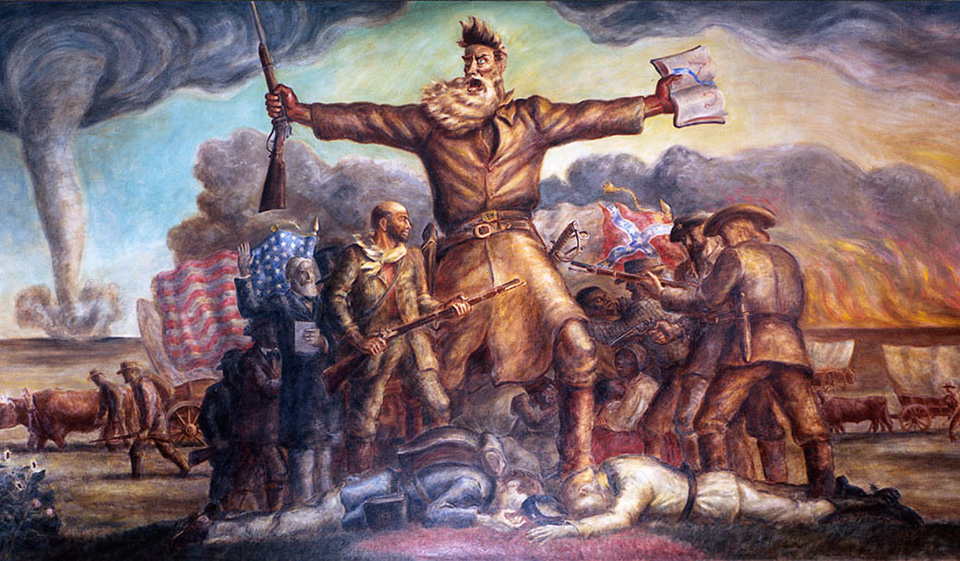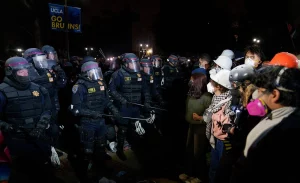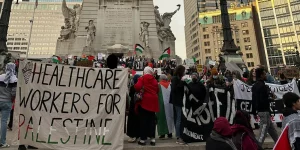This summer, as I marched alongside thousands of other people for Black lives against state sponsored racial terror, I saw a number of signs referencing one particular historical figure. Some signs, mostly carried by Black people, asked white people in the crowd to bring this person’s energy to the fight. Another sign I saw quoted his final speech, saying “I… am now quite certain that the crimes of this guilty land will never be purged away but with blood.” This figure, of course, is the divisive, committed, and legendary white abolitionist John Brown, who was executed 161 years ago this week, as much for the crime of passionately believing in the absolute equality of Black and white people as for the crimes he was executed for: murder, treason, and inciting a rebellion. After experiencing one of the largest uprisings in recent US history, and as we continue the battle for abolition, fight for the release of new political prisoners and all those kidnapped by the state, and mourn those who have been killed, what lessons can John Brown’s life, philosophy, and strategy have for us?
Life
John Brown’s life until the mid-1850s was committed and religious —- one that wouldn’t have garnered him the attention, vitriol, or acclaim that his actions during the last five years of his life did. He bounced around in different jobs, moved frequently, and was increasingly drawn to the abolitionist cause. He moved to a community in upstate New York intended to be racially equal, and became heavily involved in the Underground Railroad, helping enslaved people find their way to freedom. As law after law was passed, however, as law after law was passed, first criminalizing the act of helping a runaway and then opening up new territory to slavery, his involvement intensified, along with his beliefs. It became increasingly clear that the United States government would continue to support slavery, that peaceful resistance to it would be more and more criminalized, and that active, armed opposition would become necessary. As a Smithsonian Magazine profile of Brown recounts, “Political events of the 1850s turned Brown from a fierce, if essentially garden-variety, abolitionist into a man willing to take up arms, even die, for his cause.”
The first step he took on this road was to move to Kansas Territory in 1855, which was being invaded “with Bowie knife and pistol” by pro-slavery Missourians who were trying to ensure that Kansas would become a slave state. Brown and his sons continued their previous involvement in the Underground Railroad, as well as forming armed groups to defend fellow “free staters” and attack pro-slavery Kansans. This growing confrontation came to a head in 1856 when pro-slavery settlers attacked Lawrence, Kansas, then the center of free stater activity. In retaliation, Brown and his sons attacked and killed five pro-slavery settlers in front of their families, in what became known as the Pottawatomie massacre. Those who fear and hate John Brown, which include many of the mainstream historians of the 20th century, point to this event as evidence of his madness and his murderousness. Even his supporters question the necessity of this action, which freed no enslaved people. Black abolitionist Frederick Douglass, an ally of Brown’s, called it “a terrible remedy for a terrible malady.” At the end of the day, Brown viewed himself as a soldier in a war, willing to make sacrifices and do whatever was necessary to win. Indeed, many modern historians of the Civil War count this period, Bleeding Kansas, as the beginning of the war.
In the years that followed, as Kansas voted to become a free state. Brown lost family members, allies, and friends to pro-slavery militias and the complicit federal government. Despite these heavy losses, he continued to travel all over to raise money and gather weapons, while also leading raids to free enslaved people throughout the Midwest. He eventually joined with Harriet Tubman to begin planning the attack (which some historians call a dress rehearsal for the Civil War) that would lead to his execution: the raid on slaveholders and a US military armory in Harper’s Ferry, West Virginia. While he intended the raid to be the start of a mass slave revolt, a series of misfortunes and mistakes lead to the U.S. army becoming aware of the plan earlier than intended. Everyone in the group was either killed or arrested. Brown himself was held for a month, before being found guilty of treason against the Commonwealth of Virginia, among other crimes, and hanged.
In terms of its immediate goals — freeing enslaved people in the area and giving them the tools to free others — the raid on Harper’s Ferry was a failure. However, the consequences for it were swift and long lasting. John Brown became a martyr for the abolitionist cause, firing up white Northerners, just as he became a bogeyman for white Southerners. As author William S. McFeely points out, “Not two years after his raid, the nation was engaged in the immense violence of the Civil War that became the attack on slavery that did work.” Historian John Stauffer believes “The impact of Harpers Ferry quite literally transformed the nation” and convinced many white Americans who had previously viewed themselves as “moderate” and “reasonable”, that no compromise would be possible. John Brown biographer David Reynolds goes further, saying, “Had John Brown’s raid not occurred, it is very possible that the 1860 election would have been a regular two-party contest between antislavery Republicans and pro-slavery Democrats… The Democrats would probably have won.”
According to Dennis Frye, the chief historian at Harper’s Ferry National Historical Site, even today, “Americans do not deliberate about John Brown—they feel him.” To truly understand why John Brown’s legacy still looms so large in the American consciousness and emotional landscape, and why he is an important figure especially for those of us on the left to learn from, we need to look not just at his actions, but also at the philosophy and strategy that undergirded him.
Beliefs
Many historians have picked apart the origins of Brown’s uncompromising anti-slavery beliefs. One of the easiest roots to point to are his strict Calvinist Christian beliefs. He believed he was destined to bring an end to slavery, which was a sin against God. Additionally, he often spoke of the influence of his personal experiences. W.E.B. DuBois, the famous Black activist and author, wrote of a young Brown’s reaction to a family friend beating an enslaved boy, and his realization that the difference between how he and the boy were treated was simply their race. He and his father both became conductors on the Underground Railroad. Later, when abolitionist Elijah P. Lovejoy was murdered, Brown stood up in his church and announced, “Here, before God, in the presence of these witnesses, from this time, I consecrate my life to the destruction of slavery.” As his involvement in the abolition movement continued, he met legendary abolitionists Harriet Tubman and Frederick Douglass, who became important influences on Brown’s life and ideology. Brown was also inspired by current and historical uprisings of enslaved people in the Caribbean and United States, pointing to their leaders, such as Nat Turner, as figures of admiration. He was especially drawn to the case of La Amistad, a Spanish slave ship which was taken over by the enslaved people aboard. Said Brown, “Nothing so charms the American people as personal bravery. Witness the case of Cinques, of everlasting memory, on board the Amistad.”
In contrast to the majority of white abolitionists at the time, John Brown’s lack of personal racism and his staunch belief in the equality of Black and white people is striking. Aside from his friendships with prominent Black abolitionists such as Tubman and Douglass, he was friends with and socialized with his Black neighbors with none of the performativity or constraint that many white abolitionists did. He shocked his neighbors by treating his Black friends with basic respect, such as calling them “Mr.” and “Mrs.” He fought against racism in his own church, which, though an integrated church founded by abolitionists, made Black people sit in the back. Rather than just fighting to free enslaved people, he advocated for the complete integration and equality of Black people. Simply being less racist than the average white abolitionist in the 1850s is sadly a low bar, but as Stauffer writes, “He stood apart from every other white in the historical record in his ability to burst free from the power of racism.”
Stauffer adds, “Brown felt a profound and lifelong empathy with the plight of slaves.” While his ability to, or at least commitment to attempting to, truly empathize with Black people and their struggle often gets less attention than his use of violence, it is just as important to explaining his legacy. He did not view himself as better than or separate from enslaved people. Dubois, writing of the incident in which young Brown saw an enslaved boy his age being beaten by a man who had shown Brown himself kindness, said that Brown “readily, in his straightforward candor, acknowledged him ‘fully if not more than his equal.’” Douglass said Brown, “though a white gentleman, is in sympathy, a black man, and as deeply interested in our cause, as though his own soul had been pierced with the iron of slavery.” Brown wrote to his wife, “I want all my family to imagine themselves in the same dreadful condition,” and then went on to quote, as he often did, Hebrews 13:3 “Remember them that are in bonds, as bound with them.” Biographer Louis A. DeCaro Jr explained Brown’s deep commitment to equality by writing “his struggle against slavery was far more personal and religious than it was for many abolitionists, just as his respect and affection for black people was far more personal and religious than it was for most enemies of slavery.” Brown viewed radical equality as his guiding aim, saying “I want you to understand that I respect the rights of the poorest and weakest of colored people, oppressed by the slave system, just as much as I do those of the most wealthy and powerful. That is the idea that has moved me, and that alone.”
Together, these influences and beliefs combined to create one of the few truly anti-racist white abolitionists of the 19th century, a man uncompromising in his conviction in the evil of slavery, and the necessity for bloodshed and sacrifice to end it. Brown saw how pacifist strategies to end slavery, such as attempting to persuade slaveholders through appeals to morality, were both failing and being opposed as strongly as militant strategies. For instance, for nearly 10 years in the decades leading up to the Civil War, the U.S. House of Representatives abided by a so-called “gag rule”, automatically putting aside all petitions relating to slavery without hearing them. He said, “I don’t think the people of the slave states will ever consider the subject of slavery in its true light till some other argument is resorted to other than moral persuasion.”
Again, while often the emphasis is on Brown’s belief in the necessity of enacting violence against the supporters of slavery in order to end its evil, the person he was most willing to sacrifice was himself. While still fighting in Kansas, he told his son, “I have only a short time to live—only one death to die, and I will die fighting for this cause.” He stood by this sentiment until the end. Upon hearing his death sentence at the conclusion of his trial, he replied “…if it is deemed necessary that I should forfeit my life for the furtherance of the ends of justice, and mingle my blood further with the blood of my children and with the blood of millions in this slave country whose rights are disregarded by wicked, cruel, and unjust enactments—I submit; so let it be done!” Even on the scaffold, his commitment to bringing attention to and ending the suffering of enslaved people continued. He refused to have a priest accompany him, saying he would be more honored to go with a slave woman and her children.
Strategy
Despite his religious fervor, willingness to sacrifice himself and others, and eventual role as a martyr, John Brown was not relying on martyrdom to achieve his aims. He was a thoughtful, if not always immediately successful, strategist and tactician. He carefully studied the history of uprisings by enslaved people in the Caribbean and employed their tactics. He was especially drawn to the history of the Haitian Revolution and the maroons of Jamaica. His friend Richard Hinton said that he knew this history “by heart.” His ally, the poet and activist Richard Realf, told a Congressional hearing on Harper’s Ferry that Brown “had posted himself in relation to the wars of Toussaint L’Ouverture … he had become thoroughly acquainted with the wars in Hayti and the islands round about.”
From these examples, Brown formulated his theory of guerilla warfare, which he intended to and began to carry out in the United States. This plan involved stoking panic and fear of slave rebellion amongst Southerners, and sapping their commitment to maintaining slavery. He specifically picked Harper’s Ferry, in the heart of the mountainous Appalachian region, as a place to start this war because he realized that maroon communities, towns and societies established by formerly enslaved people in remote areas such as mountains and jungles, were the key to a successful guerilla war against slaveholders. Thomas Wentworth Higginson, a member of “the Secret Six” who funded the Harper’s Ferry raid, said that Brown planned to get “together bands and families of fugitive slaves… establish them permanently in those fastnesses, like the Maroons of Jamaica and Surinam”. These communities could serve as sites to retreat and attack from, as well as providing a long-lasting base of support for a war Brown knew would be drawn out.
Ultimately, John Brown’s raid was limited by a set of historical realities and strategic questions that made its practical success destined to fail. This much even he was aware of, which is why he attempted to persuade Frederick Douglass to accompany him and help arouse the slaves to join the revolt. Nonetheless, the raid was able to have wider political impact because of the growing contradictions and fissures between the North and the South around slavery, and the growing abolitionist movement led by leaders like Frederick Douglass and William Lloyd Garrison that sought for a mass and coordinated attack on slavery.
Legacy
Even before Brown’s death, a debate over his beliefs and strategy began. White Southerners were horrified and terrified by his unflinching opposition to slavery and millitant tactics. Even “genteel” and “reasonable” white abolitionists thought he went too far, and should have proceeded more slowly, gently, and kindly. This type of “friendly” concern, indistinguishable from ardent opposition, will be familiar to anyone who has ever fought for a more just world. However, following his execution, the tone among white Northerners shifted. Philosopher Henry David Thoreau said not long after Brown’s death, “He did not recognize unjust human laws, but resisted them as he was bid… No man in America has ever stood up so persistently and effectively for the dignity of human nature. . . .” Ever since, popular white consensus on John Brown has shifted back and forth with the political winds, reaching a nadir at the end of Reconstruction through the 1920s, when the rehabilitation of the Confederacy and support for the KKK was in vogue. Even today, a positive view of John Brown can be a good first step towards a commitment to revolutionary politics, and a negative view is a good red flag for reformism at best and conservatism at worst. As historian Albert Fried wrote, those who hate John Brown or view him as deranged are “really informing me of their predilections, their judgment of the historical event, their identification with the moderates and opposition to the ‘extremists.'”
Assessment of John Brown among Black historians, writers, and activists has been much more consistent. During his life, many Black abolitionists personally knew and deeply respected the man. Frederick Douglass called him “a brave and glorious old man” who had died for Black people, while Harriet Tubman thought he was “the greatest white man who ever lived.” The day of his execution, Black business closed and Black churches tolled their bells. Later, DuBois dubbed Brown the white American who had “come nearest to touching the real souls of black folk.” This sense of solidarity continues to today. The main avenue in Port-au-Prince, Haiti is named after John Brown, in honor of his use of the methods of the Haitian Revolution. Malcolm X said that white people could not join the Organization of Afro-American Unity, but thought for a minute and added, “if John Brown were still alive, we might accept him.” Another time, he expanded his thoughts on John Brown, adding as an admonition to potential white allies, “If you are for me and my problems – when I say me, I mean us, our people – then you have to be willing to do as old John Brown did. And if you’re not of the John Brown school of liberals, we’ll get you later – later.” McFeely sums up this feeling by writing “Brown was, and to many Black observers still is, the one white man who was unequivocally one of them.”
From his actions to his beliefs to the legacy he left behind, there is a great deal that anti-racist activists can learn from John Brown’s example. First, we can learn a model for white allyship (or accompliceship, as some prefer to think of it). Dubois wrote that his ardent and uncompromising push for equality, not just abolition, was “a sign of threat for white slave owners and those who believed that only blacks were behind the idea of freeing slaves.” If non-Black socialists stand against violence and racial terror, against prisons, and against the state alongside our Black neighbors, it is a bigger threat to the establishment. On the other hand, we should at every moment, somewhat counter to his example, work closely with those most immediately impacted, and strive to work in a robust community. Like Brown, we should be thoughtful about strategy and tactics, learning from history and determining what actions are most likely to have material consequences, and which are most likely to help shock and shake white liberals out of complacency. If we ever take a leadership role, it should be in the vein of Brown, who DuBois described as “a man whose leadership lay not in his office, wealth or influence, but in the white flame of his utter devotion to an ideal.”
In a speech during his trial, Brown declared “Had I so interfered in behalf of the rich, the powerful, the intelligent, the so-called great, or in behalf of any of their friends, either father, mother, brother, sister, wife, or children, or any of that class, and suffered and sacrificed what I have in this interference, it would have been all right; and every man in this court would have deemed it an act worthy of reward rather than punishment.” Brown viewed everyone he fought for as his equal, and viewed his own life as no more worthy of care and protection than theirs. If we want to win the fight for a better world, we need to model his empathy, his zeal, his willingness to sacrifice, and his uncompromising commitment to justice.










